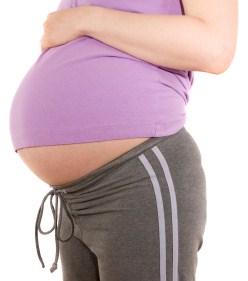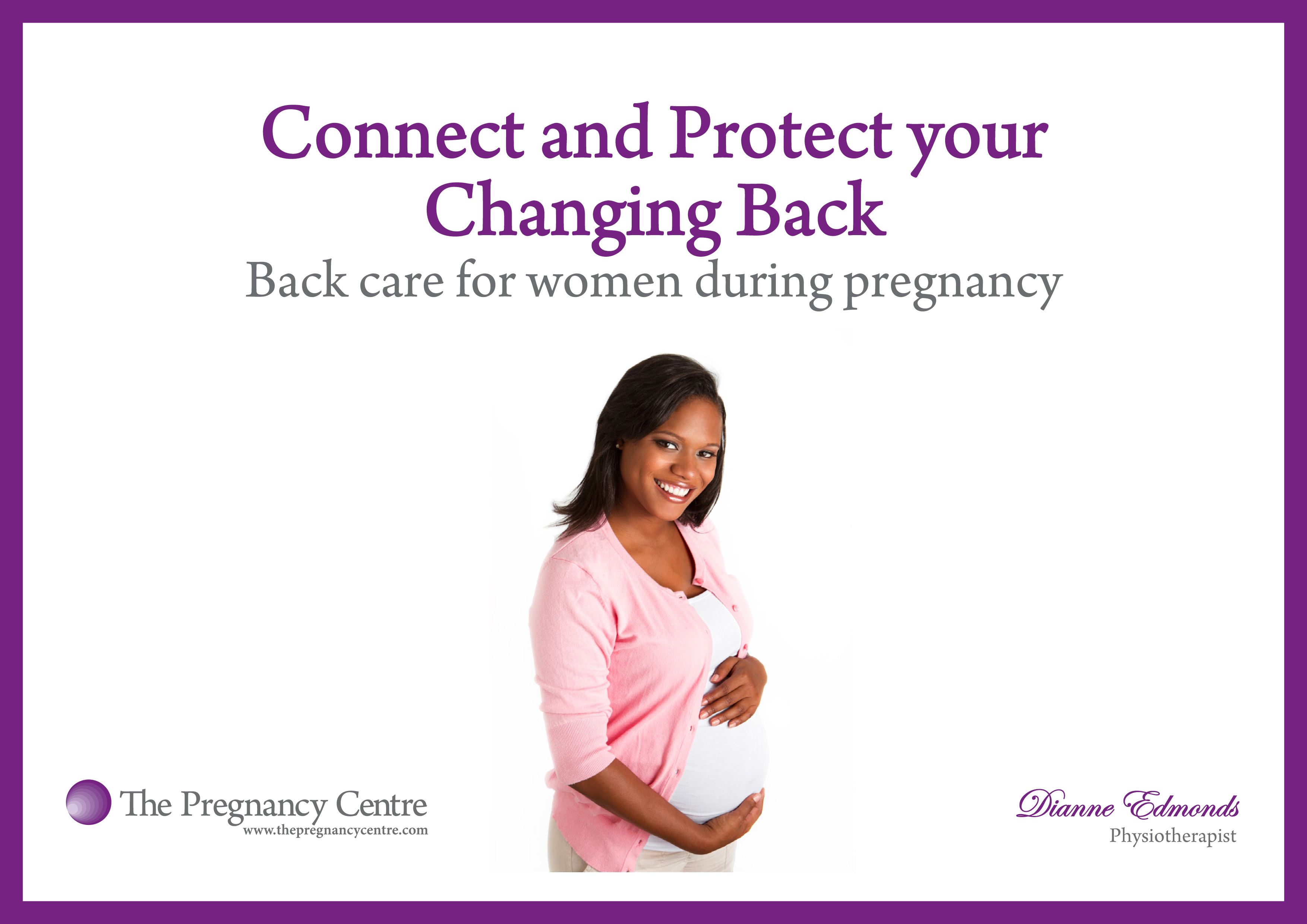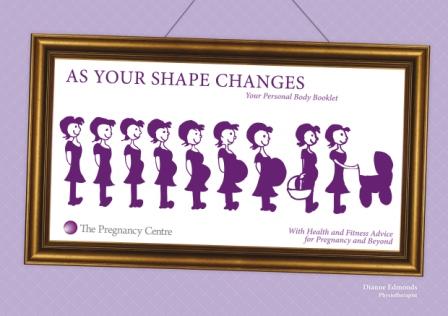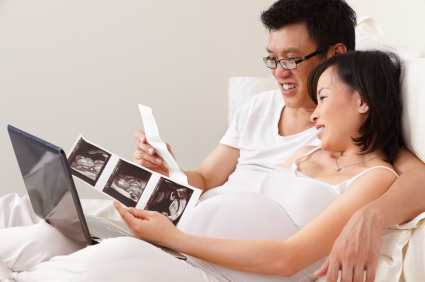Taking Care of Your Back

Did you know?
While you are pregnant there is more strain on your muscles, ligaments and joints. Hormonal softening effects occur, and your posture changes, to allow your baby or babies to grow. Pregnancy hormones are responsible for the ligaments being able to loosen and allow stretching of your muscles and 'more give' in your abdominal area. With these changes though, there is more chance of a back ache, back pain or pelvic joint pain during pregnancy. Studies show that:
 Are you pregnant?
Are you pregnant?
Do you enjoy looking after yourself and your baby?
Do you like knowing how to be strong and move easily to protect your back and baby?
If you answered YES to any of these questions then this ebooklet is for you. Click HERE to order.
How can I care for my back during pregnancy?
-
If possible, work to improve your physical fitness before you become pregnant, and between one pregnancy and the next, as this will lessen the risk of back pain.
-
Learn as much as you can and practice caring for your back before you reach twenty weeks of pregnancy. A study by Ostgaard in 1991, showed that obtaining and using information on back care and body posture before twenty weeks of pregnancy reduces the frequency of back pain during and after pregnancy. This includes appropriate abdominal exercise as strong, well functioning and toned abdominal muscles provide support for the back.
-
You can dramatically reduce your risk of back pain during pregnancy by gaining and using correct information about safe levels of exercise during pregnancy. Inappropriate exercise during pregnancy may actually induce or increase back pain (Fast et all, 1990).
Stomach muscle strength and stability
The strength, tone and function of your stomach muscles has a great effect on whether or not you experience back pain in pregnancy. Why is this?
-
The low back and pelvis need to be supported and stabilized by muscles to protect the lower spine from being injured when lifting, moving and carrying objects, including your baby in utero!
-
The deepest abdominal muscle layer is like a living corset. It helps to stabilize the spine before any movement or action. The muscles involved are called the Transversus Abdominus muscle and the Internal Obliques.
-
In people who have had back pain in the past, the deep abdominal and/or the deep back muscles may not work as well as they should. These people may be more prone to experiencing back or pelvic pain during pregnancy.
 Are you pregnant and noticing how much your body is changing?
Are you pregnant and noticing how much your body is changing?
Are you concerned that you won't be able to get your body back into shape after your baby is born?
Do you enjoy looking after your body and your baby?
If so, this booklet is FOR YOU! Click HERE to find out MORE.
What can I do to care for my back and pelvis during pregnancy?
Learning how to accurately work the deep abdominal muscles well will allow your muscles to "actively carry your baby" which can in turn help to reduce the strain on your back and pelvis from posture changes. This is most effective when done during early pregnancy; but, even women later in pregnancy who have pain, notice an improvement once they begin to work and strengthen their deep abdominal muscles accurately and correctly. There are many causes of back pain, but when your deep abdominal muscles are working well, this can definitely help.
To exercise your deep abdominal muscles during pregnancy, use the exercise called Pregnancy Abdominal Bracing, which with some checkpoints is described in the booklet, As Your Shape Changes. A Physiotherapist or Fitness Professional who works with pregnant women can also check that you are doing this exercise correctly, or teach you how to do it right if you are not sure.
Sit-ups (curl-ups) and pelvic tilting do not work the deep abdominal muscles correctly, or promote pelvic and spinal stability. Pregnancy Abdominal Bracing, as described in the booklet, As Your Shape Changes, is one of the best ways to work the deep and low abdominals during pregnancy to improve pelvic and spinal stability, and to keep your abdominal muscles toned.
What happens to your abdominal muscles after the birth?
It takes at least eight weeks after childbirth for the abdominal muscles to effectively stabilize the pelvis and protect the spine.
As the abdominal muscles stretch during pregnancy, it is necessary to work these muscles safely soon after the birth to help them . This is especially important to help prevent the development of low back pain. Effective exercise for restoring the abdominal muscles after childbirth can be fitted into the daily routine of caring for a new baby more easily than making time to do sit-ups, which do not promote the stability of the spine. One key exercise is Postnatal Abdominal Bracing, which is described in the booklet, As Your Shape Changes.
Going back to sport and high impact exercise before the abdominal muscles stabilize and support the spine properly increases the risk of a back injury. As Your Shape Changes includes some specific checks ~ ways of knowing if your muscles are back to normal and you are ready to take up sport again.
How's that back? 
Back pain is very common. 47% of women during pregnancy and 80% of Australians at some stage of their lives have back pain.
Just because it is common, it does not mean that it is normal to have back pain!!
There are different kinds of pain that can be experienced. These include:
Often the muscles in your back get tired or achy, particularly towards the end of the day. This kind of pain is often due to posture and the activities which you are doing during the day. If your abdominal muscles are weakened, e.g. during or after pregnancy (although ‘Pregnancy Abdominal Bracing’ can help keep your abdominal muscles toned in pregnancy), there is more strain on your back in the day. You may also be bending over, using your back rather than bending your knees and hips, using your stronger leg muscles.
Often paying attention to these things - your posture, bending your knees and lifting correctly, and bracing your abdominal muscles can help reduce this type of pain.
If you experience constant aching, or these tips do not help, seek professional advice. Treatment by a physiotherapist or other health professional who works with pregnant women can help.
-
Sharp, pinching or catching pain
You should not continue to put up with any pain of this nature. Rather than applying general advice (although the above tips may still be helpful) in this situation, you should seek professional advice regarding what is causing the pain and specific treatment options available.
-
Numbness or tingling or pain moving down into your leg
This indicates irritation to or pressure on the nerves from your back. You should quickly seek advice from your doctor, Physiotherapist or other health professional if you develop this problem. Do not ignore it and hope that it will just go away.
Please note: This information is not a substitute for seeking professional advice if you have or develop a back problem.
 Are you pregnant?
Are you pregnant?
Do you enjoy looking after yourself and your baby?
Do you like knowing how to be strong and move easily to protect your back and baby?
If you answered YES to any of these questions then this ebooklet is for you. Click HERE to order.
What can you do if you have a backache?
Please note: This information does not replace the need for professional advice if you do have an injury or a problem which persists.
(Do not use if you have recently hurt your back or had an injury. Seek professional advice.) The heat from a hot pack can help to improve the blood flow to your aching muscles and help them to relax. There are different forms of hot packs which you can use. It is important to make sure that you don't have it too hot. It should just feel comfortably warm while you are using it against the area of your back that is aching. You can use heat for up to 15 to 20 minutes at a time, even as often as every 3 to 4 hours.
If you stand and let your tummy sag there will be more strain against your back. Stand tall and keep your lower tummy area drawn in if you need to stand in one position for any period of time. Your shoulders should be pulled back and slightly down, your chin tucked in and your knees gently fixed, not pushed back.
Remember, the advice in the booklet As Your Shape Changes which you can pick up HERE if you haven't got your copy yet. Bend your knees and hips as you move to pick things up from a low height. This will save you from getting a back ache.
Get a friend or your partner to gently massage the area. This helps to improve the blood flow to the area and relax the muscles. If you really feel like spoiling yourself, book yourself in for a massage from a professional who works with pregnant women.
Relaxation can help your muscles to relax, which means less tension in your back and like massage, improved blood flow to the muscles. Simple relaxation such as gently lowering your shoulders, loosening your fingers and breathing out as you do this, and repeating this two to three times, is a starting point for learning more relaxation tips.
-
Check the height of your equipment
Bending over low pram handles, a change table or high chair can give you a backache. So can picking up baby capsules regularly.
If you are pregnant, think about these things when purchasing your equipment so that you don't run into these problems when your baby is born.
One that you can do if you are pregnant or have had a baby is the 'cat stretch', which is described in most pregnancy exercise programs. On your hands and knees, curl your back like a cat, hold this stretch for as long as comfortable then move back into the starting position. Repeat 4 to 10 times, providing that this feels comfortable and you get NO pain with this exercise.
If you have a problem which persists, seek the advice of your doctor, physiotherapist or other health professional. Continuing to put up with problems can wear you down. They don't just go away by themselves as most people think they will.
Check your posture
Do you ever get an aching back at the end of the day, or sore neck muscles? Sometimes when you get tired, it is hard to maintain good posture. This can add up to more aches and strains on your tired muscles. Try some of the following reminders and ideas to lift yourself up again.
-
Imagine a string attached to the back of your head, and someone gently lifting it up.
Feel your spine gently lengthening from the neck to your upper back and then your lower spine, lifting up one vertebra at a time.
-
Compare slouching with sitting or standing tall
Slouch and feel this position, then sit or stand up straight. Then repeat this four more times, until you can really feel the difference in being in an upright position.
-
Imagine a broomstick running through your spine
Use this idea to help you stand tall, instead of letting your back sag when you get tired.
-
Lie down if you are tired rather than slumping
If you are very tired and it is difficult to keep your body in a good sitting position at the end of the day, it might be better to lie down on the couch to read or watch television, rather than sit in a slumped position.

A simple way to improve your posture
When you are pregnant, your posture can change quite a lot. The arch in your lower back gets bigger and your upper back can start to curl forwards. Your shoulders can move forwards and you can become round shouldered. Together with this, instead of your head being held upright it can move forwards so that your chin pokes out further.
To a point these changes are fine during pregnancy, but if they become exaggerated then there is more strain than necessary on your spine during your pregnancy. If these posture changes stay after your pregnancy then they can be there for the rest of your life. Later on, if you become pregnant with another child and with the help of gravity, the rounded shoulders and a stooped neck can become a permanent feature, or become the new you.
Don't let pregnancy do this to you - or if it has, it is never too late to do something about it.
Use this wall exercise to help you regain your correct posture.
Note: If you have a back or neck problem before you start this, please seek further advice first from your Doctor, Physiotherapist or other health professional.
Stand with your back against the wall. Your bottom should be against the wall also. Try to place your shoulders and head against the wall. If this feels uncomfortable or unnatural, and there is a big gap between your shoulders or head and the wall, then it may take time to correct your posture. Doing this over the days and weeks ahead, slowly and gradually you can help to restore your good posture.
Good posture is when your head and shoulders are against the wall and your ears are in line with your shoulders. You should be able to maintain this position when you are away from the wall too. That is the key! Once you can do this against the wall, then you need to keep that posture for short intervals during the day. Gradually increase the time that you hold this position and your muscles will adapt to the new position to hold you there permanently.
Precaution
Now you should not feel stiff and uncomfortable when doing this. If you do, you may be trying too hard or correcting your posture too much for where you are at the moment. Back off just a little bit. That is, just push your head and shoulders back a little less and learn to hold this position first. As your posture improves, then you can gently keep moving your head and shoulders back, using the wall to correct your position first.
During the day it is easy to `let go’ and slouch, letting gravity pull you down. Using your muscles to hold you in position will again help to strengthen them, so it will get easier over time. As your body adjusts, you may sometimes feel different aches. This is your muscles adapting to your new position. Persevere through this, but you should not experience any real pain in your back or neck while doing these movements. If this does occur please seek advice from your Medical Practitioner, Physiotherapist or other Health Professional.
Copyright 2013-2020. Demac Resources Pty Ltd. www.thepregnancycentre.com.au
Click here to download a free factsheet called "Caring for your back"